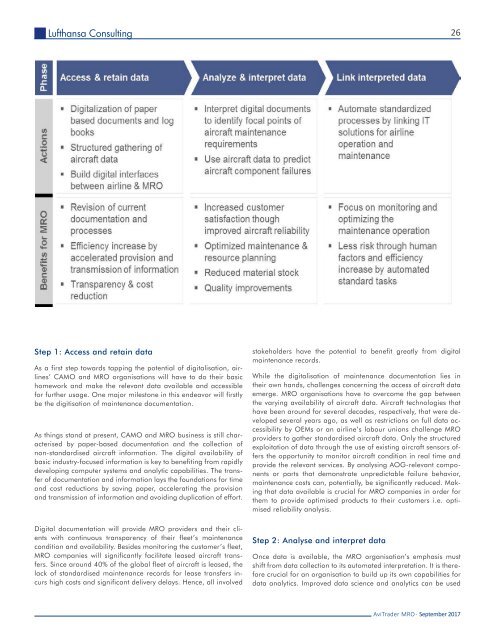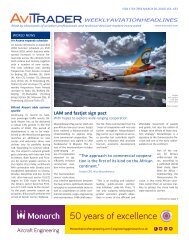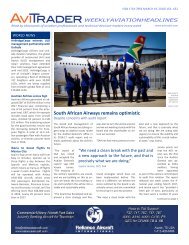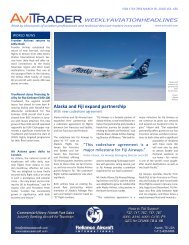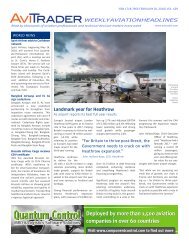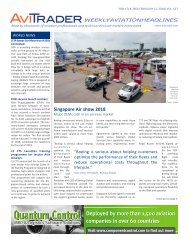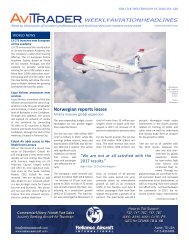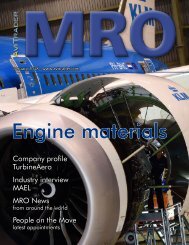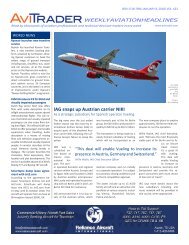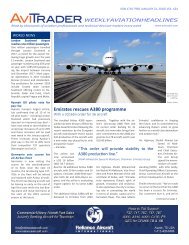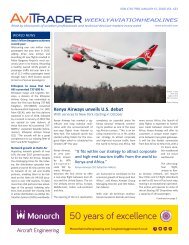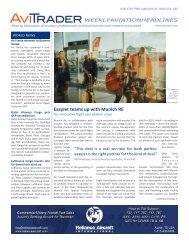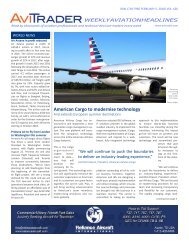AviTrader MRO Magazine 2017-09
AviTrader MRO Magazine 2017-09
AviTrader MRO Magazine 2017-09
You also want an ePaper? Increase the reach of your titles
YUMPU automatically turns print PDFs into web optimized ePapers that Google loves.
Lufthansa Consulting<br />
26<br />
Step 1: Access and retain data<br />
As a first step towards tapping the potential of digitalisation, airlines’<br />
CAMO and <strong>MRO</strong> organisations will have to do their basic<br />
homework and make the relevant data available and accessible<br />
for further usage. One major milestone in this endeavor will firstly<br />
be the digitisation of maintenance documentation.<br />
As things stand at present, CAMO and <strong>MRO</strong> business is still characterised<br />
by paper-based documentation and the collection of<br />
non-standardised aircraft information. The digital availability of<br />
basic industry-focused information is key to benefiting from rapidly<br />
developing computer systems and analytic capabilities. The transfer<br />
of documentation and information lays the foundations for time<br />
and cost reductions by saving paper, accelerating the provision<br />
and transmission of information and avoiding duplication of effort.<br />
Digital documentation will provide <strong>MRO</strong> providers and their clients<br />
with continuous transparency of their fleet’s maintenance<br />
condition and availability. Besides monitoring the customer’s fleet,<br />
<strong>MRO</strong> companies will significantly facilitate leased aircraft transfers.<br />
Since around 40% of the global fleet of aircraft is leased, the<br />
lack of standardised maintenance records for lease transfers incurs<br />
high costs and significant delivery delays. Hence, all involved<br />
stakeholders have the potential to benefit greatly from digital<br />
maintenance records.<br />
While the digitalisation of maintenance documentation lies in<br />
their own hands, challenges concerning the access of aircraft data<br />
emerge. <strong>MRO</strong> organisations have to overcome the gap between<br />
the varying availability of aircraft data. Aircraft technologies that<br />
have been around for several decades, respectively, that were developed<br />
several years ago, as well as restrictions on full data accessibility<br />
by OEMs or an airline’s labour unions challenge <strong>MRO</strong><br />
providers to gather standardised aircraft data. Only the structured<br />
exploitation of data through the use of existing aircraft sensors offers<br />
the opportunity to monitor aircraft condition in real time and<br />
provide the relevant services. By analysing AOG-relevant components<br />
or parts that demonstrate unpredictable failure behavior,<br />
maintenance costs can, potentially, be significantly reduced. Making<br />
that data available is crucial for <strong>MRO</strong> companies in order for<br />
them to provide optimised products to their customers i.e. optimised<br />
reliability analysis.<br />
Step 2: Analyse and interpret data<br />
Once data is available, the <strong>MRO</strong> organisation’s emphasis must<br />
shift from data collection to its automated interpretation. It is therefore<br />
crucial for an organisation to build up its own capabilities for<br />
data analytics. Improved data science and analytics can be used<br />
<strong>AviTrader</strong> <strong>MRO</strong> - September <strong>2017</strong>


